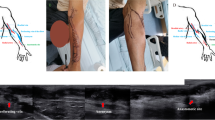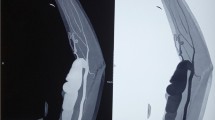Abstract
Background
Pseudoaneurysm (PS) and aneurismal dilation of vein (ADV) are recognized complications of arteriovenous fistulas (AVF) in patients on hemodialysis. We present our experience about surgical management of these complications, which resulted in AVF preservation for continuing hemodialysis.
Material and methods
Twenty-two patients underwent surgical repair of an aneurismal dilation of vein or a pseudoaneurysm arising from a native AVF. In 14 patients the aneurismal dilation of vein arose from the venous limb of AVF and in eight patients the pseudoaneurysm arose from an arteriovenous anastomotic site in the antecubital and anterior part of arm. The mean follow-up period was 15 months. Clamp Aneurysm Repair (CAR) was performed to repair the aneurismal dilation of venous limb of AVF and Tourniquet Aneurysm Repair (TAR) was performed to repair PS that arose from AVF in the antecubital and anterior part of arm.
Results
In eight of the 14 patients with aneurismal dilation of vein, who underwent CAR procedure, vascular access was preserved. In three patients with aneurismal dilation of vein in snuffbox and one in forearm, the AVF had failed due to prior venous thrombosis of AVF. In two of 14 patients, there was no need for preservation of AVF because of renal transplantation. The technical success rate and patency rate during follow up period in CAR method was 100%. In seven of eight patients with psudoaneurysm in the antecubital and anterior part of arm, who underwent TAR procedure, the AVF remained patent. The technical success rate in TAR method was 87.5%, and the patency rate was 87.5%. Overall, technical success rate was 95.45% and patency rate was 93.75%. During the 15 months of follow up period hemodialysis program through the repaired AVF sustained as desired.
Conclusions
The surgical methods used in our study could effectively repair the aneurismal dilation of vein and psudoaneurysm arising from a native AVF, and it lead to preservation of the AVF patency for continuing hemodialysis. These methods are technically feasible, safe and cost-effective procedures. It does not require dissection and additional incision for control of the vein and artery proximal and distal to the aneurismal dilation of vein and pseudoaneurysm; result in shorter time of procedure without complications.
Similar content being viewed by others
References
Windus DW (1993) Permanent vascular access: A nephrologist’s view. Am J Kidney Dis 21:457–471
Kherlakian GM, Rodersheimer LR, Arbaugh JJ, Newmark KJ, King LR (1986) Comparison of autogenous fistula versus expanded polytetrafluoroethylene graft fistula for angioaccess in hemodialysis. Am J surg 152:238–243
Enzler MA, Rajmon T, Lachat M, Largiader F (1996) longterm function of vascular access for hemodialysis. Clin Transplant 10:511–515
Clark TW, Abraham RJ (2000) Thrombin injection for treatment of brachial artery pseudoaneurysm at the site of a hemodialysis fistula: report of two patients. Cardiovasc Intervent Radiol 23:396–400
Karabay O, Yetkin U, Silistreli E, Uskent H, Onol H, Acikel U (2004) Surgical management of giant aneurysm complicating arteriovenous fistula. J Int Med Res 32:214–217
Witz M, Werner M, Bernheim J, Shnaker A, Lehmann J, Korzets Z (2000) Ultrasound-guided compression of pseudoaneurysms complicating a forearm dialysis arteriovenous fistula. Nephrol Dial Transplant 15:1453–1454
Najibi S, Bush RL, Terramani TT, Chaikof EL, Gunnoud AB, AB, MBCh, Weiss VJ (2002) Covered Stent Exclusion of Dialysis Access Pseudoaneurysms. J Surg Res 106:15–19
Haimovici H (1996) Peripheral arterial aneurysms. In Haimovici’s Vascular Surgery: Principles and Techniques, 4th edn Haimovici H, Ascer E, Holier HL, Stradness DE, Towne JB, eds). Cambridge, Massachusetts: Blackwell Science, pp 893–907
O’sullivan GJ, Ray SA, Lewis JS, Lopez AJ, Powell BW, Moss AH et al (1999) A review of alternative approaches in the management of iatrogenic femoral pseudoaneurysms. Ann R Coll Surg Engl 81:226–234
Sharma NK, Chin KF, Modgill VK (2001) Pseudoaneurysms of the femoral artery: recommendation for a method of repair. J Royal Coll Surg Edinb 46:195–197
Webber GW, Jang J, Gustavson S, Olin J (2007) Contemporary Management of Post Catheterization Pseudoaneurysms. Circulation 115:2666–2674
Coley BD, Roberts AC, Fellmeth BD, Valji K, Bookstein JJ, Hye RJ (1995) Postangiographic femoral artery pseudoaneurysms: further experience with US-guided compression repair. Radiology 194:307–311
Lange P, Houe T, Helgstrand UJ (2001) The efficacy of ultrasound-guided compression of iatrogenic femoral pseudoaneurysms. Eur J Endovasc Surg 21:248–250
Taylor BS, Rhee RY, Muluk S, Trachtenberg J, Walters D, Steed DL, et al (1999) Thrombin injection versus compression of femoral artery pseudoaneurysms. J Vasc Surg 30: 1052–1059
Owen RJT, Haslam PJ, Elliott ST, Rose JDG, Loose HW (2000) Percutaneous ablation of peripheral pseudoaneurysms using thrombin: a simple and effective solution. Cardiovasc Intervent Radiol 23:441–446
Paulson EK, Nelson RC, Mayes CE, Sheafor DH, Sketch MH Jr, Kliewer MA (2001) Sonographically guided thrombin injection of iatrogenic femoral pseudoaneurysms: Further experience of a single institution. Am J Roentgenol 177: 309–316
Mohler ER 3rd, Mitchell ME, Carpenter JP, Strandness DE Jr, Jaff MR, Beckman JA et al (2001) Therapeutic thrombin injection of pseudoaneurysms: a multicenter experience. Vasc Med 6:241–244
Khoury M, Rebecca A, Greene K, Rama K, Colaiuta E, Flynn L, et al (2002) Duplex scanning-guided thrombin injection for the treatment of iatrogenic pseudoaneurysms. J Vasc Surg 35:517–521
Friedman SG, Pellerito JS, Scher L, Faust G, Burke B, Safa T (2002) Ultrasound-guided thrombin injection is the treatment of choice for femoral pseudoaneurysms. Arch Surg 137: 462–464
Hessel JS, Adams JF, Adams HL (1981) Complications of angiography. Radiology 138:273–281
Brener BJ, Couch NP (1973) Peripheral arterial complications on left heart catheterization and their management. Am J Surg 125:521–526
Romono M, Lo Monte A, Buscemi G (1995) Complications of vascular accesses in hemodialysis (in Italian). Ann Ital Chir 66:27–35
Thalhammer C, Kircherr, AS, Uhlich F, Waigand J, Gross CM (2000) Postcatheterization pseudoaneurysms and arteriovenous fistulas: repair with percutaneous implantation of endovascular covered stents. Radiology 214:127–131
Silas AM, Bettman MA (2003) Utility of covered stent for revision of aging failing synthetic hemodialysis grafts: a report of three cases. Cardiovasc Intervent Radiol 26:550–553
Rabindranauth P, Shindelman L (1998) Transluminal stent graft repair for pseudoaneurysm of PTFE hemodialysis grafts. J Endovasc Surg 5:138–141
Chua TP, Howling SJ, Wright C, Fox KM (1998) Ultrasound-guided compression of femoral pseudoaneurysms: an audit of practice. Int J Cardiol 28:245–50
Hajarizade H, Larosa CR, Cardullo P, Rohere MJ, Cutler BS (1995) Ultrasound-guided compression of iatrogenic femoral pseudoaneurysm failure, reccurence and long term results. J Vasc Surg 22:425–433
Sheiman RG, Brophy DP, Perry LJ, Akbari CM (1999) Thrombin injection for the repair of brachial artery pseudoaneurysms. AJR Am J Roentgenol 173:1029–1010
Author information
Authors and Affiliations
Corresponding author
Rights and permissions
About this article
Cite this article
Shojaiefard, A., Khorgami, Z., Kouhi, A. et al. Surgical management of aneurismal dilation of vein and pseudoaneurysm complicating hemodialysis arteriovenuos fistula. Indian J Surg 69, 230–236 (2007). https://doi.org/10.1007/s12262-007-0032-2
Received:
Accepted:
Published:
Issue Date:
DOI: https://doi.org/10.1007/s12262-007-0032-2




